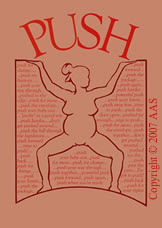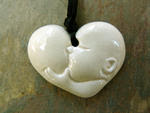On homebirthdebate,
From Someone:
Amy, I posted the other day numerous stories of deaths that occurred as a direct result of birthing in a hospital with careless attendants who were healthy and would have been fine at home. All you have to do is go read stories where deaths have occured in the hospital. How did the baby or mother die? Were they otherwise healthy? Would they have survived if the intervention or a different model of care had been applied? That's not too easy to figure out, and I've posted already SEVERAL stories where being in the hospital caused a death that wouldn't have occured at home.
Someone, please feel free to post your information here. There are those who believe that the women who chooses homebirth is putting her needs before her baby's (based on one person's belief in the excess of neonatal death rates at home). First, judgements and decisions ought to be withheld until there is a thorough study of the long term impact of the interventions that save babies' lives in the hospital. With medical caregivers shrugging their shoulders over cause of colic and the advice "it'll just go away" and research and education on incidence, cause, and cure for SIDS, for example, has does the public trust that infant mortality rates are not related to birth trauma? Who pays for and supports the research that supports the medical field? There has not been an adequate, honest, scientific look at the REASONS for infant mortality rates within the first year of life.
Second, please check out the Safe Motherhood Quilt Project. This is a memorial project for the women who have died in childbirth since 1982. Few, if any of these women, died in homebirths. I have seen this quilt twice and it is powerful. I was honored to hold it for others to pass by and read the names of the women as Ina May Gaskin shared each woman's story.
http://www.rememberthemothers.net/quilt/thumbnails.php?album=4.
Any woman with birthing experiences in the hospital, such as myself, can not help but whisper the prayer, "But by the Grace of God, go I."
Also visit The Tatia Oden French Memorial Foundation. Thirty-two year old healthy Tatia Oden and her baby, both died as a result of uterine rupture after Cytotec induction. www.tatia.org/index.hmtl
History:
In Dec. 2001, Tatia Oden French entered a well-known and well-respected hospital to deliver her first child. She was 32 years old, in perfect health, and looking forward to a natural, unassisted childbirth. There were no problems during the pregnancy. According to her doctor's calculations, she was a little under 2 weeks overdue. She was given the drug Cytotec to induce her labor. Cytotec, also known as Misoprostol, is a drug manufactured to treat ulcers. It is NOT approved by the FDA, or the drug company, to induce labor. Ten hours after being administered Cytotec, Tatia suffered hyper-stimulation of her uterus, an amniotic fluid embolism (AEF) was released, an emergency C-Section was performed because the baby was also in distress. Both Tatia and her baby Zorah died in the operating room. The Tatia Oden French Memorial Foundation, a non-profit corporation, was formed in March 2003 to give ALL women of childbearing age complete information concerning medical interventions and drugs which are administered during childbirth. We do this hoping that women may then be able to make FULLY informed decisions regarding the birth of their children.
The Tatia Oden French Memorial Foundation offers presentations regarding the issues of maternal mortality, informed consent and the off-label use of drugs-specifically the use of Cytotec to induce labor. We strive to provide as much information as possible to as many people as possible regarding these issues. We believe that ALL known side effects of the various drugs and procedures used in labor and delivery, should be explained to women BEFORE they agree to these interventions. Without this information it is impossible to give fully INFORMED consent.
http://tatia.org/index.html
Natural Birthing Options: Technology in Birth- First Do No Harm
By Marsden Wagner. M.D.
To understand why so much unnecessary technology is used during pregnancy and birth, it is necessary to understand how technology comes to be used. We must first ask, is the use of a new technology preceded by careful scientific evaluation, then followed by official approval for use and requirements for education of doctors in its use? Sadly, the truth lies in another direction. An example of a recent birth technology now rapidly spreading in the United States will illustrate the reality.
Several years ago a drug with the generic name misoprostol (called Cytotec by the drug company that manufactures it) was approved by the Food and Drug Administration (FDA) as a prescription drug to be used for certain ailments of the stomach. It is known that one of its side effects is severe cramps or contractions of the uterus, and for this reason the label says it should never be used on pregnant women. Obstetricians, however, discovered that given orally or vaginally, Cytotec, because of its side effect of violent uterine cramping, can induce (start) or accelerate labor.
So without any prior testing of Cytotec for labor induction, obstetricians began to use it on their birthing women. Doctors on the Internet began to describe their experience with this new way of inducing labor. One doctor wrote, "I must say I have heard some great things about Cytotec myself. Just be careful. The stuff turns the cervix to complete MUSHIECytotec for labor induction "cannot be recommended for routine use at this stage."
That Cytotec is not approved by the FDA for labor induction, is not approved for this use by the drug manufacturer (who still states on the label that it is not to be given to pregnant women), is not endorsed by the American College of Obstetricians and Gynecologists or midwifery organizations, nor does it have scientists' approval for routine use-all has had no apparent effect on the enthusiasm with which doctors are starting to use it. And there is nothing to stop doctors from using Cytotec for this "off label" purpose because although the FDA must approve a drug before it goes on the market, once it is on the market for a specified purpose, any doctor can use it in any dose for any purpose on any patient.
After one obstetrician in South Dakota proudly told me over lunch that he was the first doctor in his community to use Cytotec for labor induction and now urges other doctors to use it, he justified his actions: "We will wait forever for the bureaucrats at the FDA in Washington DC to approve drugs, so we must try them out ourselves if we want progress." When asked, he admitted he doesn't tell the women to whom he is giving Cytotec that the drug is not approved for this purpose, nor does he ask for informed consent. He scoffed at my suggestion that he is experimenting on women without their knowledge, much less their consent. The Oregon State Health Department told me their records show Cytotec to be the most common way of inducing labor in that state, and it is used on thousands of laboring women.
The use of Cytotec on birthing women has spread like wildfire for a very simple reason, told to me by many doctors: its use brings back the possibility of "daylight obstetrics"-that is, women brought to the hospital first thing in the morning and induced with Cytotec will give birth by late afternoon and the doctor can be home for dinner. How many women will have their uterus ruptured before a court case finally applies the brakes to this practice? I personally welcome learning of cases where Cytotec induction was used without fully informed consent and there was subsequent uterine rupture, cervical laceration or other serious complications.
The unsystematic, untested way in which Cytotec for labor induction was introduced and disseminated is typical for the technologies used during pregnancy and birth. Ultrasound scanning during pregnancy and electronic fetal monitoring during labor are further examples of uncontrolled introduction and dissemination of untested technologies. There is a big gap between what we know to be the best scientific maternity care practices and what is actually practiced. As a result, there is no consumer protection except litigation. Doctors blame lawyers and women for the fact that over 70 percent of American obstetricians have been sued one or more times, but litigation is the only way a woman and her family can protect themselves against malpractice.
http://www.mercola.com/2000/apr/9/natural%20birthing%20options.htm
The Other Side of the Glass
Part One was officially released June 2013 in digital distribution format.
To purchase to to www.theothersideoftheglass.com
If you were a donor and want to download your copy send an email to theothersideoftheglassfilm@gmail.com.
The trailer
Monday, January 15, 2007
Subscribe to:
Post Comments (Atom)
"Soft is the heart of a child. Do not harden it."
A public awareness reminder that things that happen behind the scenes, out of our sight, aren't always as rosy as we might think them to be. Perhaps its a restaurant cook who accidentally drops your burger
on the floor before placing it on the bun and serving it to you. Here it's an overworked apathetic (pathetic) nurse giving my newborn daughter her first bath.
Please comment and rate this video, so as to insure that it is viewed as widely as possible, perhaps to prevent other such abuse. -- The mother who posted this YouTube. How NOT to wash a baby on YouTube
Are you going to try to tell me that "babies don't remember?" There is no difference to this baby's experience and the imprinting of her nervous system/brain and one that is held and cleaned by the mother or father either at the hospital or at home?
By the way, this is probably NOT the baby's first bath. The nurse is ungloved. Medical staff protocol is that they can't handle a baby ungloved until is has been bathed (scrubbed if you've seen it) because the baby is a BIO-HAZARD -- for them. Never mind that the bio-hazard IS the baby's first line of defense against hospital germs.
Missouri Senator Louden Speaks
Finally, A Birth Film for Fathers
Part One of the "The Other Side of the Glass: Finally, A Birth Film for and about Men" was released June, 2013.
Through presentation of the current research and stories of fathers, the routine use of interventions are questioned. How we protect and support the physiological need of the human newborn attachment sequence is the foundation for creating safe birth wherever birth happens.
Based on knowing that babies are sentient beings and the experience of birth is remembered in the body, mind, and soul, fathers are asked to research for themselves what is best for their partner and baby and to prepare to protect their baby.
The film is designed for midwives, doulas, and couples, particularly fathers to work with their caregivers. Doctors and nurses in the medical environment are asked to "be kind" to the laboring, birthing baby, and newborn. They are called to be accountable for doing what science has been so clear about for decades. The mother-baby relationship is core for life. Doctors and nurses and hospital caregivers and administrators are asked to create protocols that protect the mother-baby relationship.
Men are asked to join together to address the vagaries of the medical system that harm their partner, baby and self in the process of the most defining moments of their lives. Men are asked to begin to challenge the system BEFORE they even conceive babies as there is no way to be assured of being able to protect his loved ones once they are in the medical machine, the war zone, on the conveyor belt -- some of the ways that men describe their journey into fatherhood in the medicine culture.
Donors can email theothersideoftheglassfilm@gmail.com to get a digital copy.
Through presentation of the current research and stories of fathers, the routine use of interventions are questioned. How we protect and support the physiological need of the human newborn attachment sequence is the foundation for creating safe birth wherever birth happens.
Based on knowing that babies are sentient beings and the experience of birth is remembered in the body, mind, and soul, fathers are asked to research for themselves what is best for their partner and baby and to prepare to protect their baby.
The film is designed for midwives, doulas, and couples, particularly fathers to work with their caregivers. Doctors and nurses in the medical environment are asked to "be kind" to the laboring, birthing baby, and newborn. They are called to be accountable for doing what science has been so clear about for decades. The mother-baby relationship is core for life. Doctors and nurses and hospital caregivers and administrators are asked to create protocols that protect the mother-baby relationship.
Men are asked to join together to address the vagaries of the medical system that harm their partner, baby and self in the process of the most defining moments of their lives. Men are asked to begin to challenge the system BEFORE they even conceive babies as there is no way to be assured of being able to protect his loved ones once they are in the medical machine, the war zone, on the conveyor belt -- some of the ways that men describe their journey into fatherhood in the medicine culture.
Donors can email theothersideoftheglassfilm@gmail.com to get a digital copy.
Buy the film at www.theothersideoftheglass.com.
The film focuses on the male baby, his journey from the womb to the world and reveals healing and integrating the mother, father, and baby's wounded birth experience. The film is about the restoring of our families, society, and world through birthing loved, protected, and nurtured males (and females, of course). It's about empowering males to support the females to birth humanity safely, lovingly, and consciously.
Finally, a birth film for fathers.
The film focuses on the male baby, his journey from the womb to the world and reveals healing and integrating the mother, father, and baby's wounded birth experience. The film is about the restoring of our families, society, and world through birthing loved, protected, and nurtured males (and females, of course). It's about empowering males to support the females to birth humanity safely, lovingly, and consciously.
Finally, a birth film for fathers.
What People Are Saying About the FIlm
Well, I finally had a chance to check out the trailer and .. wow! It's nice that they're acknowledging the father has more than just cursory rights (of course mom's rights are rarely acknowledged either) and it's great that they're bringing out the impact of the experience on the newborn, but I'm really impressed that they're not shying away from the political side.
They are rightly calling what happens in every American maternity unit, every day, by its rightful name - abuse. Abuse of the newborn, abuse of the parents and their rights, abuse of the supposedly sacrosanct ethical principal of patient autonomy and the medico-legal doctrine of informed consent, which has been long ago discarded in all but name. I love it!
In the immortal words of the "shrub", "bring it on!" This film needs to be shown and if I can help facilitate or promote it, let me know.
Father in Asheville, NC
Thanks for sharing this. It was very touching to me. I thought of my brother-in-law standing on the other side of the glass when my sister had to have a C-section with her first child because the doctor was missing his golf date. I'll never forget his pacing back and forth and my realizing that he was already a father, even though he hadn't been allowed to be with his son yet.
Margaret, Columbia, MO
They are rightly calling what happens in every American maternity unit, every day, by its rightful name - abuse. Abuse of the newborn, abuse of the parents and their rights, abuse of the supposedly sacrosanct ethical principal of patient autonomy and the medico-legal doctrine of informed consent, which has been long ago discarded in all but name. I love it!
In the immortal words of the "shrub", "bring it on!" This film needs to be shown and if I can help facilitate or promote it, let me know.
Father in Asheville, NC
OMG'ess, I just saw the trailer and am in tears. This is so needed. I watch over and over and over as fathers get swallowed in the fear of hospitals birth practice. I need a tool like this to help fathers see how very vital it is for them to protect their partner and baby. I am torn apart every time I see a father stand back and chew his knuckle while his wife is essentially assaulted or his baby is left to lie there screaming.
Please send me more info!!!!
Carrie Hankins
CD(DONA), CCCE, Aspiring Midwife
720-936-3609
Thanks for sharing this. It was very touching to me. I thought of my brother-in-law standing on the other side of the glass when my sister had to have a C-section with her first child because the doctor was missing his golf date. I'll never forget his pacing back and forth and my realizing that he was already a father, even though he hadn't been allowed to be with his son yet.
Margaret, Columbia, MO
In case you don't find me here
Soon, I'll be back to heavy-duty editing and it will be quiet here again. I keep thinking this blog is winding down, and then it revives. It is so important to me.
I wish I'd kept a blog of my journey with this film this past 10 months. It's been amazing.
I have a new blog address for the film, and will keep a journal of simple reporting of the journey for the rest of the film.
www.theothersideoftheglassthefilm.blogspot.com
I'll be heading east this week to meet with a group of men. I plan to post pictures and clips on the film blog.
I'll keep up here when I can -- when I learn something juicy, outrageous, or inspiring related to making birth safer for the birthing baby.
I wish I'd kept a blog of my journey with this film this past 10 months. It's been amazing.
I have a new blog address for the film, and will keep a journal of simple reporting of the journey for the rest of the film.
www.theothersideoftheglassthefilm.blogspot.com
I'll be heading east this week to meet with a group of men. I plan to post pictures and clips on the film blog.
I'll keep up here when I can -- when I learn something juicy, outrageous, or inspiring related to making birth safer for the birthing baby.
Review of the film
Most of us were born surrounded by people who had no clue about how aware and feeling we were. This trailer triggers a lot of emotions for people if they have not considered the baby's needs and were not considered as a baby. Most of us born in the US were not. The final film will include detailed and profound information about the science-based, cutting-edge therapies for healing birth trauma.
The full film will have the interviews of a wider spectrum of professionals and fathers, and will include a third birth, at home, where the caregivers do a necessary intervention, suctioning, while being conscious of the baby.
The final version will feature OBs, RNs, CNMs, LM, CPM, Doulas, childbirth educators, pre and perinatal psychologists and trauma healing therapists, physiologists, neurologists, speech therapists and lots and lots of fathers -- will hopefully be done in early 2009.
The final version will include the science needed to advocated for delayed cord clamping, and the science that shows when a baby needs to be suctioned and addresses other interventions. Experts in conscious parenting will teach how to be present with a sentient newborn in a conscious, gentle way -- especially when administering life-saving techniques.
The goal is to keep the baby in the mother's arms so that the baby gets all of his or her placental blood and to avoid unnecessary, violating, and abusive touch and interactions. When we do that, whether at home or hospital, with doctor or midwife, the birth is safe for the father. The "trick" for birthing men and women is how to make it happen in the hospital.
The full film will have the interviews of a wider spectrum of professionals and fathers, and will include a third birth, at home, where the caregivers do a necessary intervention, suctioning, while being conscious of the baby.
The final version will feature OBs, RNs, CNMs, LM, CPM, Doulas, childbirth educators, pre and perinatal psychologists and trauma healing therapists, physiologists, neurologists, speech therapists and lots and lots of fathers -- will hopefully be done in early 2009.
The final version will include the science needed to advocated for delayed cord clamping, and the science that shows when a baby needs to be suctioned and addresses other interventions. Experts in conscious parenting will teach how to be present with a sentient newborn in a conscious, gentle way -- especially when administering life-saving techniques.
The goal is to keep the baby in the mother's arms so that the baby gets all of his or her placental blood and to avoid unnecessary, violating, and abusive touch and interactions. When we do that, whether at home or hospital, with doctor or midwife, the birth is safe for the father. The "trick" for birthing men and women is how to make it happen in the hospital.








No comments:
Post a Comment